Network Marketing Industry Statistics By Size, Profit, Future, Income, Sales, Regions And Success
Updated · Oct 08, 2024

WHAT WE HAVE ON THIS PAGE
- Introduction
- Editor’s Choice
- What is Network Marketing?
- How Does Network Marketing Work?
- Network Marketing Industry Size Statistics
- Multiple Level Marketing Profit Statistics
- Independent Distributors In Network Marketing
- Future Of Network Marketing In India 2025
- Network Marketing Revenue And Direct Sales Statistics
- MLM Consumer Statistics And Insights
- Women In Multiple Level Marketing Statistics
- MLM Regional Statistics
- Network Marketing Failure And Success Rate Statistics
- Difference Between Multi-level Marketing And Pyramid Schemes
- Multi Level Marketing Social Sales Statistics
- Conclusion
Introduction
Network Marketing Industry Statistics: Network marketing is an industry that keeps changing to meet consumer needs and new technologies. Right now, some exciting trends will affect how businesses do network marketing. Network marketing is a business model that focuses on sales made by independent representatives, who usually work from home.
In this type of business, you may need to build a network of partners, salespeople, or entrepreneurs to help find leads and make sales. Network marketing is known by several names, including multi-level multi-level marketing (MLM), cellular marketing, pyramid schemes, consumer-direct marketing, referral marketing, and home-based business franchising. Let’s take a look at the latest Network Marketing Industry Statistics and trends for 2024.
Editor’s Choice
- About 84% of people who start in network marketing do it part-time.
- The worldwide network marketing industry is valued at over $192 billion.
- Network Marketing Industry Statistics stated that almost 73% of direct sellers are women.
- On average, network marketers earn around $2,400 each year.
- Most network marketers (96%) are aged between 25 and 54.
- More than 90 million people are involved in network marketing around the globe.
- In the US, the network marketing industry is worth $200 billion.
- The top 1% of network marketers make an average of $65,000 annually.
- Network Marketing Industry Statistics stated that about 20% of network marketers earn over $100,000 each year.
- There are over 20 million people engaged in network marketing in the US.
- 67% of network marketers are satisfied with their jobs, as stated by Network Marketing Industry Statistics.
- More than 20% of network marketers have a college education.
- The global network marketing industry is expected to reach $650 billion by 2025.
- More than 20 million Americans are involved in MLM (multi-level multi-level marketing) or have tried it before.
- One-third of people in MLM got started through friends.
- Network Marketing Industry Statistics stated that almost 89% of top salespeople believe social media is important for closing sales.
- The US is the world leader in MLM, with $40.2 billion in direct sales.
- The global market for MLM software is expected to grow at a rate of 8.3% each year from 2021 to 2029.
- More than 60% of network marketers are involved in the beauty and personal care sector.
- In 2020, 75% of people participating in direct selling in the US were women.
- Network Marketing Industry Statistics stated that about 25% of MLM participants make a profit.
What is Network Marketing?
Network marketing is a business model where products are sold directly by independent salespeople instead of a full-time sales staff hired by the company. Typically, these salespeople buy products in bulk from the manufacturer and sell them on their own, often hosting sales events for friends and family.
Many network marketing companies operate in different areas, including well-known brands that sell makeup, clothing, and household items. Most sales happen when salespeople purchase large amounts of products to resell. If you’re considering joining a network marketing company, it’s important to do your homework first to ensure it has a profit-making system.
How Does Network Marketing Work?
The best way to set up a network marketing organization is to have salespeople buy high-quality products and sell them for a profit. For this type of company to work well, the products need to meet a real need in the market.
In this model, salespeople can choose their hours and create their schedules. The company saves money on marketing because it’s usually the salesperson’s job to promote their products and events.
Some network marketing companies use a multi-level multi-level approach called multi-level multi-level marketing (MLM). In this structure, they recruit new salespeople by selling them a starter package that includes the products they will sell. When these new salespeople make sales, a part of their profit goes to the person who recruited them. This setup encourages new salespeople to recruit others so they can earn commissions from their sales and from the sales made by those they bring in.
Network Marketing Industry Size Statistics
- The global network marketing industry is worth over $192 billion.
- More than 90 million people are part of network marketing worldwide.
- In the United States, this industry is valued at around $200 billion.
- Network Marketing Industry Statistics state that over 20 million individuals are involved in network marketing in the US.
- In 2020, network marketing companies in the US made over $35 billion in revenue.
- The industry grew by 13% in 2020, even during the pandemic.
- It is expected that the global network marketing market will reach $650 billion by 2025.
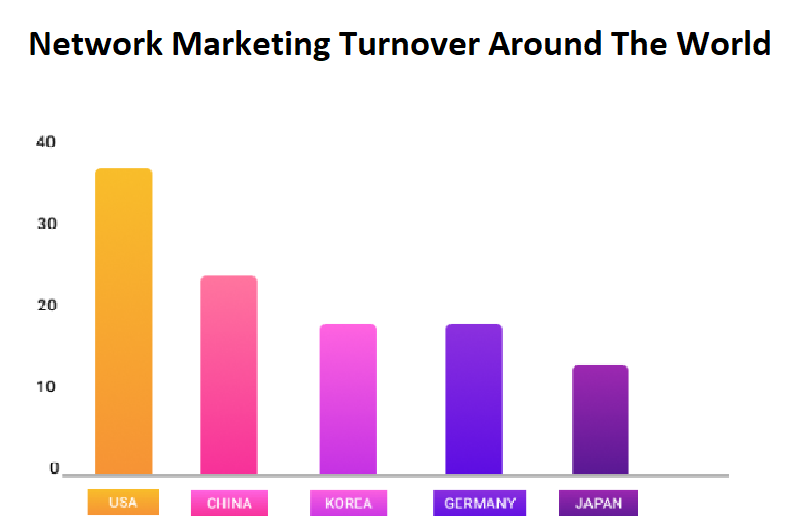 (Source: infinitemlmsoftware.com)
(Source: infinitemlmsoftware.com)
- There are more than 116 million distributors in network marketing worldwide.
- About 75% of network marketers need to recruit new members.
- Over 55 million people globally are involved in network marketing.
- This industry accounts for more than $180 billion in sales worldwide.
- Around 78% of network marketers spend between $50 and $100 each month on their business.
- The average retention rate for network marketing companies is between 61-86%.
- The industry has grown at an annual rate of 6.2% over the past five years.
- Network marketing companies employ over 20 million people worldwide.
- In the US, there are more than 18 million distributors.
- The network marketing industry has a 10% yearly growth rate as per Network Marketing Industry Statistics.
- About 65% of network marketers focus on health and wellness products.
- The industry contributes over $200 million to charity every year.
- Network marketing has created over 2.5 million jobs in the US
- The mobile phone is the most popular tool used by network marketers to grow their business.
- The global direct selling industry, which includes network marketing, has annual sales of over $193 billion.
- In Europe, network marketing has a growth rate of 10-20% each year.
- The average network marketing presentation lasts between 45-90 minutes.
- More than 40% of network marketers find leads through social media.
- Network marketing companies offer products in many areas, including skincare, health supplements, and home goods.
- 56% of network marketers work with multiple companies or opportunities at the same time.
- This industry operates in over 100 countries around the world.
- In the US, network marketing is a $180 billion industry.
- It makes up 20% of all sales in the health industry.
- More than 60% of network marketers are involved in the beauty and personal care sector.
- The network marketing industry has doubled in size since 2018.
- It is projected to grow by 5-10% annually over the next five years.
- The average network marketer spends $50-$100 each month on their business.
- 82% of network marketers use social media to promote their business.
- Network marketing companies sell products in over 20 different industries.
- The average network marketer has a team of 10 people.
- The industry has an average annual growth rate of 6%, as per Network Marketing Industry Statistics.
- Over 70% of network marketers are involved in the travel and hospitality field.
- Network marketing companies usually have a customer retention rate of 70%.
Multiple Level Marketing Profit Statistics
- About 25% of people in MLM (multi-level multi-level marketing) make a profit. This means only one out of four participants earns money. Many others don’t make anything 27% break even, and 50% lose money.
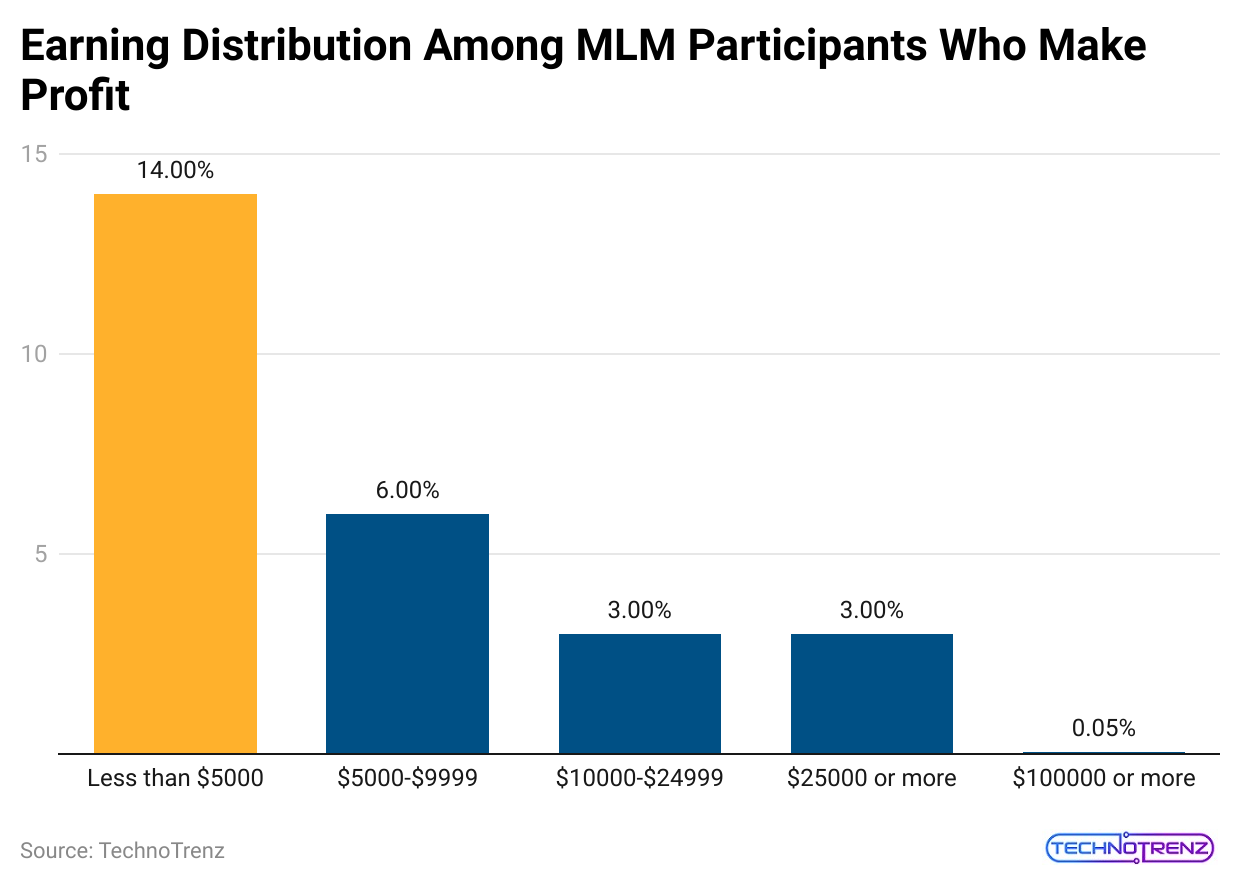 (Reference: truelist.co)
(Reference: truelist.co)
- Only 0.05% of Multi Level Marketing participants get around $100,000 or more. Among those who gain a profit, only some earn large amounts.
- About 4% make $25,000 or more, another 4% earn between $10,000 and $24,999, 7% earn between $6,000 and $9,999, and 15% earn lower than $5,000.
- 95% of Multi Level Marketing participants come out in the first ten years. This shows a high failure rate; however, about 34% of small-scale markets sustained for at least ten years. Additionally, around 50% of people in MLM leave after just one year.
- Just 42% of MLM participants said they got a double of the company’s income disclosing statement.
- This means less than 50% received this important information. Of those who did, 17% thought it was very proper, and half of them believed it was accurate.
- In contrast, 24% stated that it was somewhat inaccurate, while 10% felt it was completely inaccurate.
- The total cost to run a successful recruitment-stated multiple-level marketing campaign is about $26,000.
- Starting a good business campaign can be expensive, as stated in Network Marketing Industry Statistics.
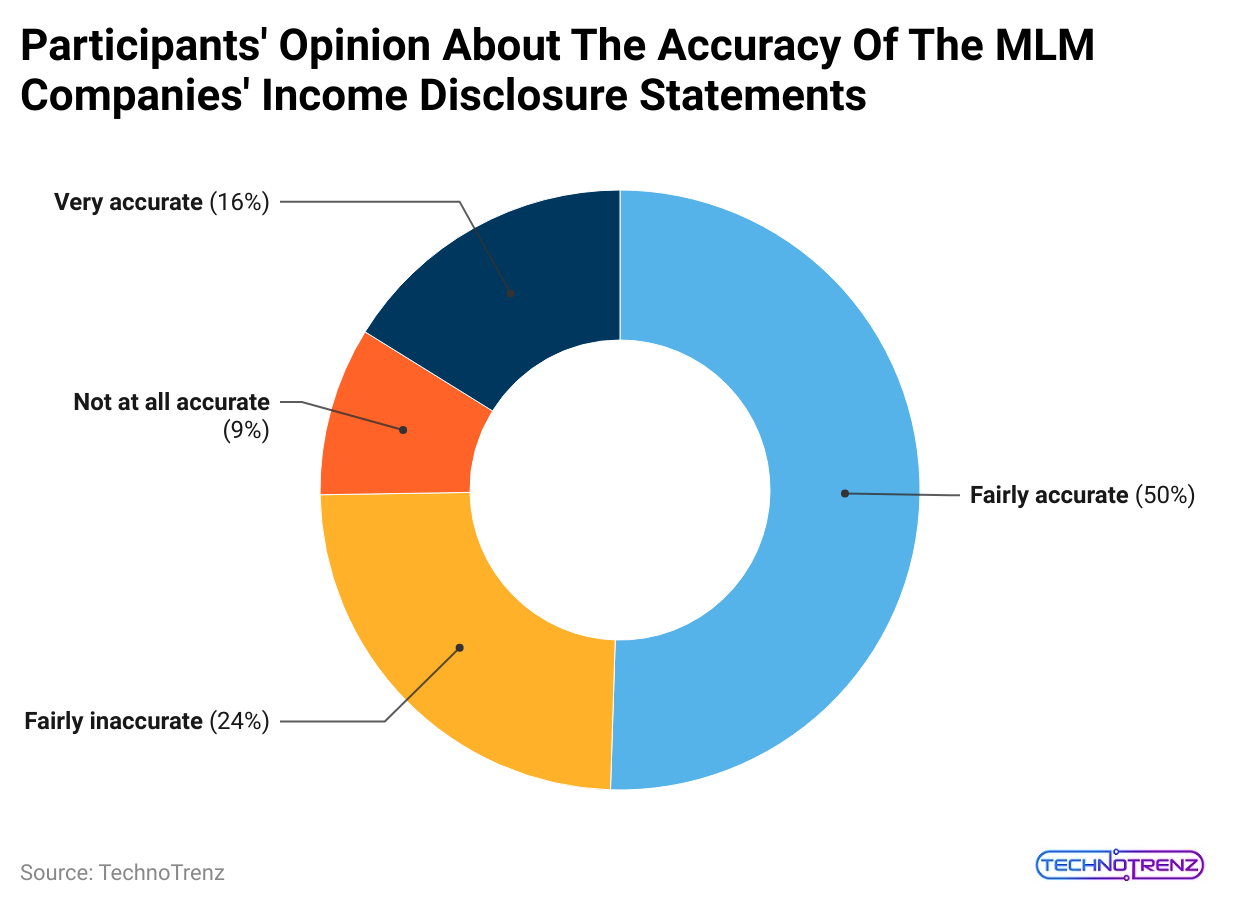 (Reference: truelist.co)
(Reference: truelist.co)
- 66% of Multiple Level Marketing participants spend $2,000 or less on inventory, training, and materials. About 24% spend between $2,000 and $5,000, while 12% pay $6,000 or more.
- 24% need to find out how much they’ve spent. Only four people reported spending almost $60,000.
- This industry can make millionaires, with some saying it offers more chances than other types of marketing, like affiliate marketing.
- According to Network Marketing Industry Statistics, 21% of millionaires globally have built their wealth through network marketing.
Independent Distributors In Network Marketing
Independent distributors in network marketing have many roles, acting as both business owners and salespeople. Their main tasks include:
- Sales and Marketing: Distributors are the primary sellers of products or services. They attract customers using strategies such as social media, in-person events, and word-of-mouth.
- Customer Relationship Management: Distributors must build and maintain good relationships with customers. They often serve as the main contact for clients, answering questions, providing product information, and ensuring customer satisfaction.
- Recruitment: Distributors are encouraged to grow their teams by recruiting new members. This involves mentoring and helping recruits succeed within the network.
Distributors are not employees; they are independent contractors. This comes with a few key points:
- Flexibility: Distributors can set their hours and work at their own pace, choosing methods that fit their strengths and preferences.
- Entrepreneurial Spirit: Distributors run their businesses. They manage finances, track sales, and plan for growth.
- Earnings Structure: Unlike employees who get a fixed salary, distributors earn money based on their sales and how well their teams perform. The more successful they and their recruits are, the more they can earn.
Understanding this relationship between distributors and the network marketing company is important to grasping the network marketing model’s independent and entrepreneurial nature.
Future Of Network Marketing In India 2025
With current trends, network marketing in India is expected to reach $645 billion (INR 645 billion) by 2025, having a big impact on social and economic factors.
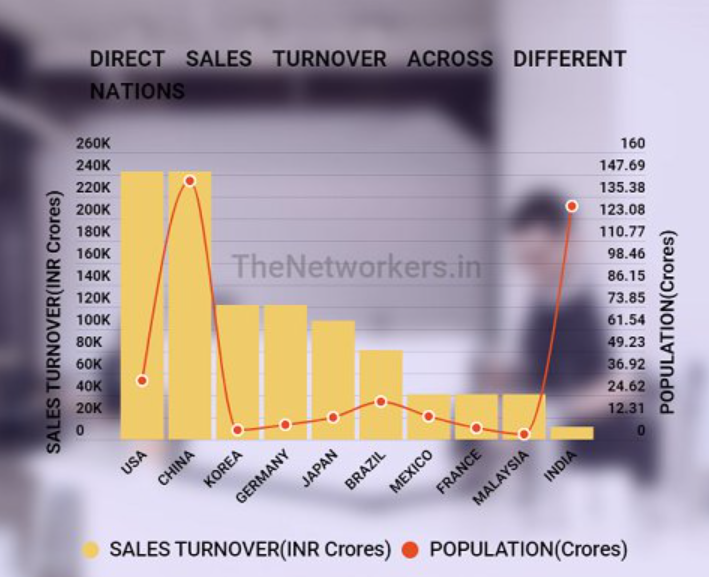 (Source: quora.com)
(Source: quora.com)
#1. Passive Income Opportunities
Network marketing gives many people the chance to earn passive income, promoting small business ownership. About 5 million distributors are involved in MLM businesses to earn this extra income.
#2. Women’s Empowerment
In 2013, around 3.4 million women worked as distributors in the MLM industry. This model helps empower women by allowing them to balance their time and work more effectively.
#3. Opportunities for SMEs
Direct selling companies frequently launch new products and rely on small and medium-sized enterprises (SMEs) to improve these products. This partnership creates opportunities for SMEs to work with MLM companies on new promotions.
#4. Increased Job Creation
While network marketing provides passive income, it also creates many job opportunities. MLM companies often work with various vendors for tasks like packaging and distribution.
#5. Social Responsibility Initiatives
Network marketing companies are active in supporting social causes. Projects from major MLM companies, such as Amway’s Sunrise Project and Avon’s Breast Cancer Crusade, help address social issues.
#6. Contribution to the Government Sector
MLM companies contribute significantly to government revenue through taxes, which helps boost the Indian economy. In 2013, tax revenue was about $1.3 billion (INR 10 billion), including both direct and indirect taxes.
Network Marketing Revenue And Direct Sales Statistics
- ZipRecruiter reports that the median network businessman in the US makes about $35,430 each year.
- Network Marketing Industry Statistics show that almost 126 million businessmen earn money through direct selling. They also mention that total sales are present in more than 171 nations.
- According to Network Marketing Industry Statistics, 74% of the public included in direct sales globally are females, while 27% are men.
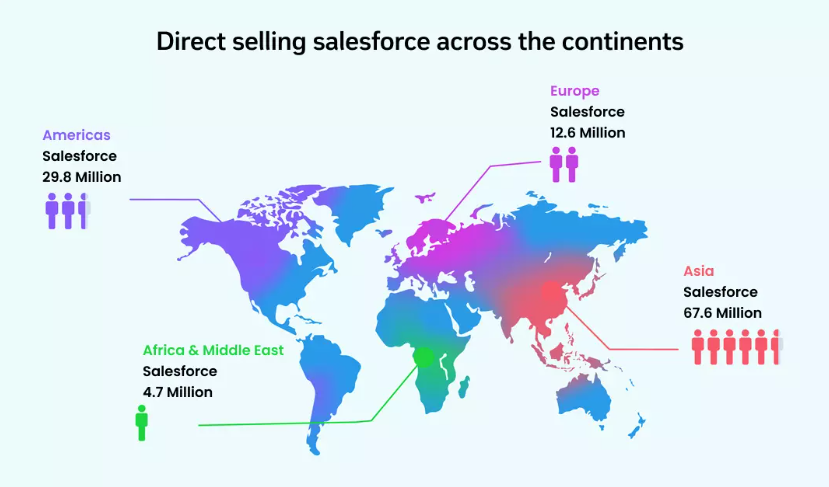 (Source: epixelmlmsoftware.com)
(Source: epixelmlmsoftware.com)
- Multi-level marketing and network businessmen generally work a median of 14.3 hours each week.
- The typical monthly total profit for an active Amway distributor in 2023 is $766.
- Dexter Yager, Amway’s top distributor, sells almost $3 billion rate of goods every year.
- According to Network Marketing Industry Statistics, the median top gainer in direct sales makes up to $21,000 each month, totaling about $240,000 a year.
- Following are the four gainers in the total sales industry:
| Rank | Name | Month-wise income (predicted) | Annual Income (Predicted) | Company |
| 4. | Allan Badilla | $867,000 | $10,404,000 | Zeta Group |
| 3. | Jenna Zwagil | $1.06 million | $12.7 million | MyDailyChoice |
| 2. | Viraj Patil | $1.2 million | $14.6 million | Ix Global |
| 1. | Jessie Lee Ward | $1.5 million | $18 million | Pruvit |
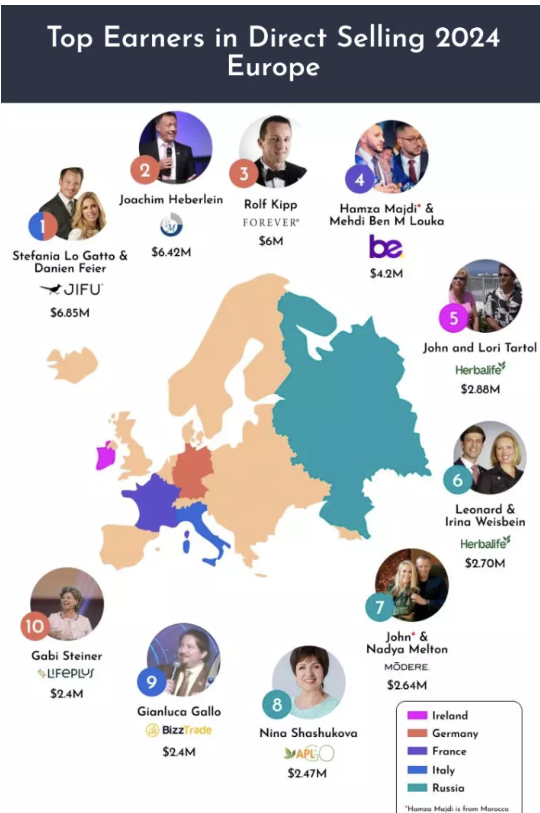 (Source: enterpriseappstoday.com)
(Source: enterpriseappstoday.com)
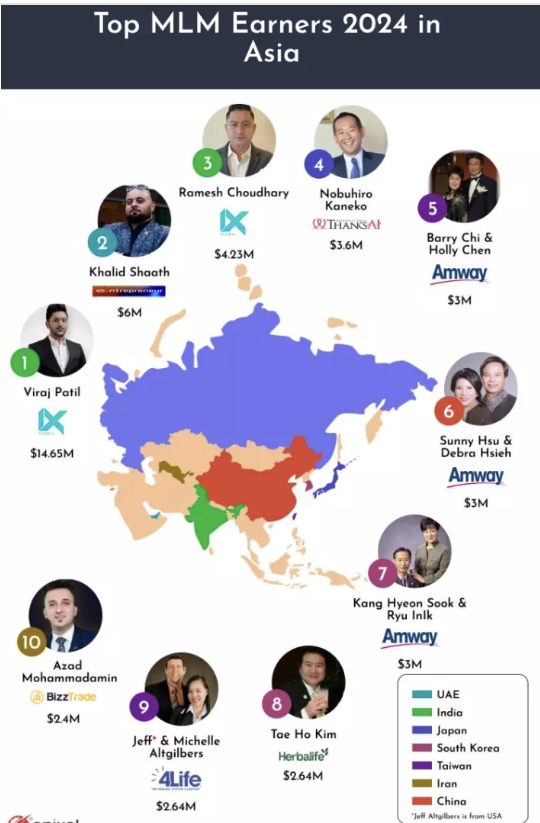 (Source: enterpriseappstoday.com)
(Source: enterpriseappstoday.com)
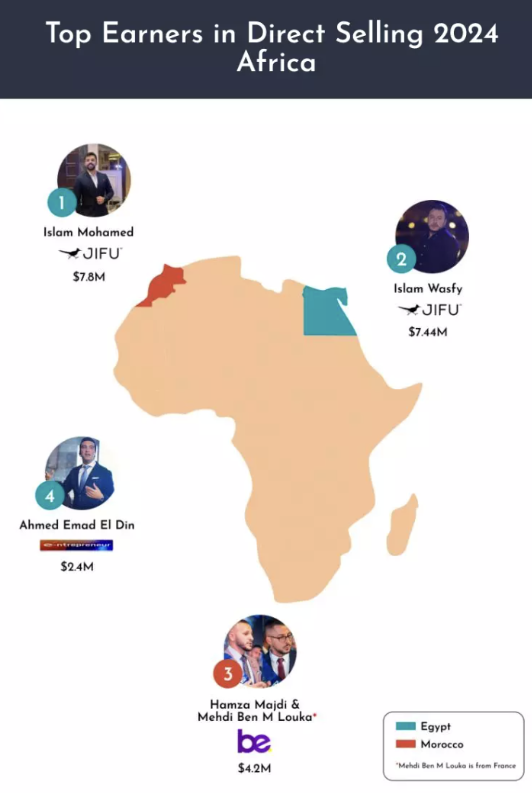 (Source: enterpriseappstoday.com)
(Source: enterpriseappstoday.com)
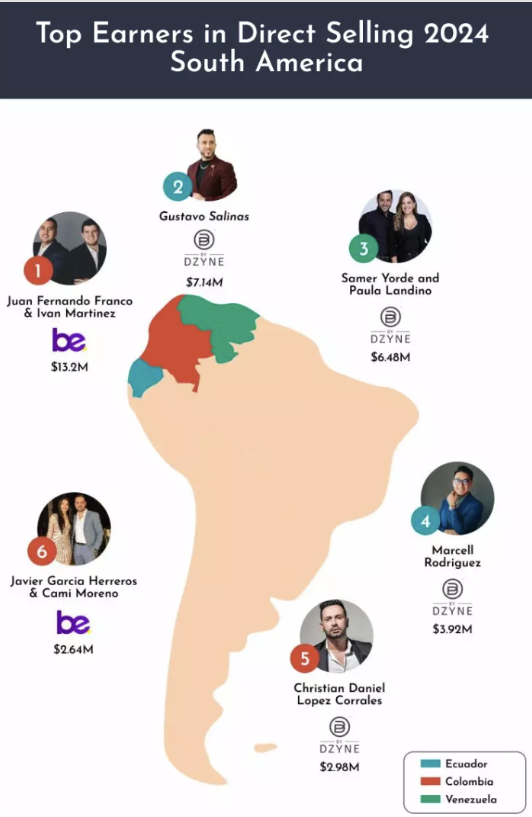 (Source: enterpriseappstoday.com)
(Source: enterpriseappstoday.com)
 (Source: enterpriseappstoday.com)
(Source: enterpriseappstoday.com)
MLM Consumer Statistics And Insights
- Consumers are the people who ultimately use products and form opinions about them.
- If they like a product, they will keep using it until something new, like better offers from other brands, catches their interest. This can be a challenge for direct-selling companies.
- Those who succeed in keeping their customers around for a long time do well.
- It’s important to deliver quality products consistently and ensure customers are happy. Understanding what customers need and focusing on them is crucial for success.
- Different age groups have different reasons for choosing products from various brands.
- A business succeeds when it appeals to all age groups. If older customers still prefer your product when shopping, it shows strong and lasting trust in your brand.
- There are 41 million preferred customers and discount buyers in the US.
- The number of US customers dropped by 8% from 2023, as per Network Marketing Industry Statistics.
- Network Marketing Industry Statistics stated that the number of preferred customers in the US is 33.1 million.
- Discount buyers in the US are 7.9 million, as per Network Marketing Industry Statistics.
- 40% of direct selling markets have included preferred member programs, with nearly 30 million participants reported in 2021.
- 20% of direct selling prospects in the US are African American.
- 48% of direct selling prospects are women, as stated in Network Marketing Industry Statistics.
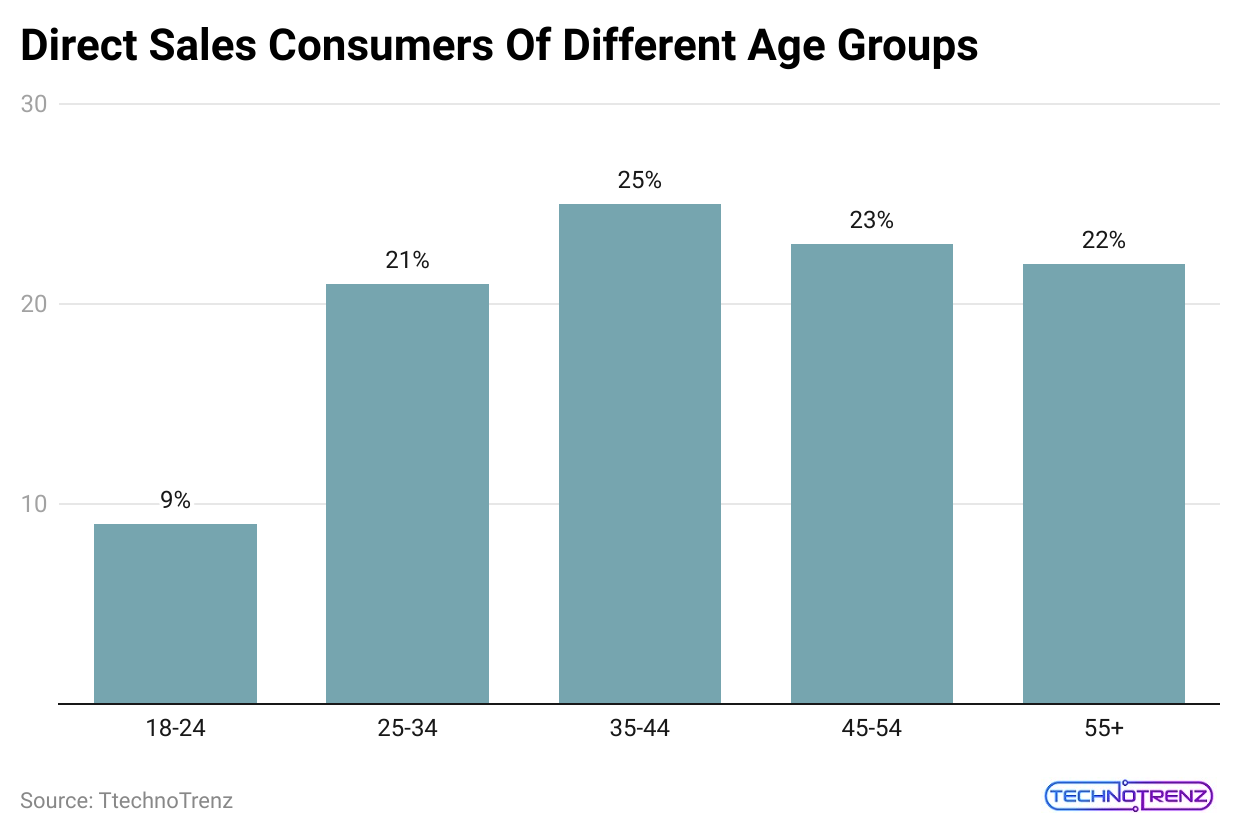 (Reference: epixelmlmsoftware.com)
(Reference: epixelmlmsoftware.com)
- Millennials make up 35% of direct selling prospects.
- US consumers generally view direct selling positively, and this view has stayed stable over the past ten years
- 69% appreciate supporting small businesses through direct selling.
- 67% value the personalized service that direct sellers provide.
- 46% of Americans are open to being contacted by direct sellers about business opportunities on social media.
- For 32% of shoppers, protecting their health and family is a key factor in buying decisions.
- According to Network Marketing Industry Statistics, 76% say product quality is the main reason they use direct selling.
- Other important reasons include the relationship with the sales consultant (71%) and customer service (47%).
- It’s essential for sales efforts to engage younger generations, as they are the future.
- It is important to gain customers’ trust in products. Companies should also work to balance gender representation in their marketing strategies.
In 2023:
- 9% of direct sellers were aged 18-24.
- People aged 25-34 made up 21% of the direct-selling population.
- About 25% of direct sellers were aged 35-44.
- 23% were aged 45-54.
- 23% of direct-selling customers were 55 and older.
- 74% of direct sellers are women, while 26% are men.
- Gen Z states for almost 11% of the industry.
- 91% of Gen Z individuals are interested in flexible income opportunities.
Women In Multiple Level Marketing Statistics
- In 2023, 75% of people involved in direct selling in the US were women. This means women make up most of the direct sellers, while men account for only 25%.
- Around 75% of women in MLM (multi-level multi-level marketing) have yet to gain experience in commission-based sales.
- Most MLM sellers are women, and many start with a background in this type of work.
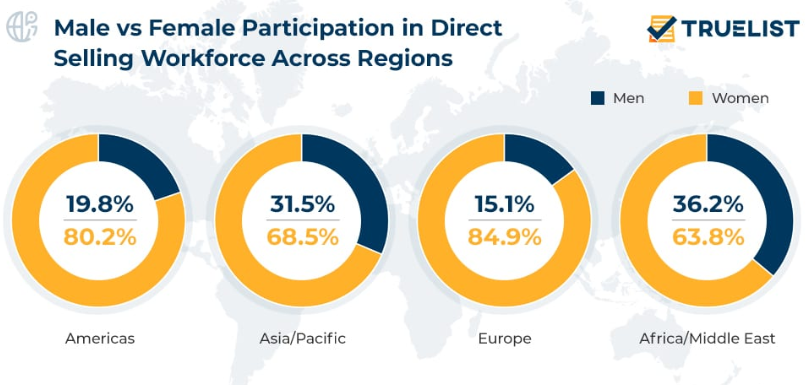 (Source: truelist.co)
(Source: truelist.co)
- Among MLM participants, 66% have gone to college or graduated, compared to 60% of those without similar job experience.
- Around 2.7 million women in India work in network marketing and direct selling.
- The industry has strong female participation, with women representing 53% of all women in the labor market.
- Overall, female participation in the labor market in India is about 23.3%.
- In Europe, women make up 84.9% of direct sellers, which shows that they are generally more active in network marketing than men.
- In Europe, the ratio is 84.9% women to 15.1% men. In the Americas, 80.2% of the population is women and 19.8% is men.
- In the Asia-Pacific region, the numbers are 68.5% women to 31.5% men, while in Africa and the Middle East, it’s 63.8% women and 36.2% men.
MLM Regional Statistics
- In 2023, the direct selling industry earned $172.8 billion in retail sales.
- Overall, global direct sales fell by 1.5% compared to the previous year.
- Network Marketing Industry Statistics stated that out of 70 global markets, 47 showed positive growth in retail sales.
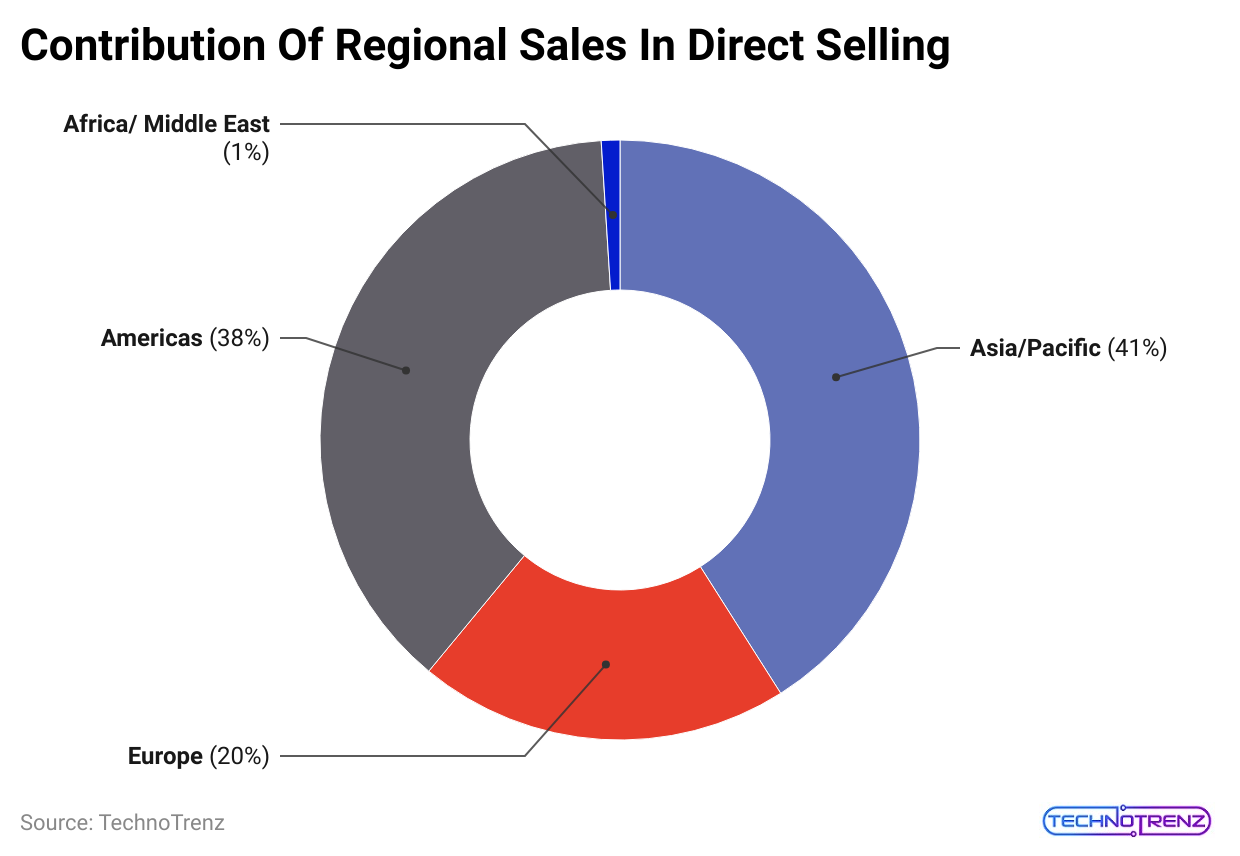 (Reference: epixelmlmsoftware.com)
(Reference: epixelmlmsoftware.com)
- The top 10 markets made up 78% of all global sales in the network marketing sector.
- The US accounted for 23% of global sales, with Korea at 11% and Germany at 10%.
- The US is the leading country in retail sales, generating $40.5 billion each year.
- Retail sales in the US have increased by 40% over the last ten years.
- Korea is second, with total retail sales of $18.4 billion.
- Network Marketing Industry Statistics stated that Germany is in third place, making $17.9 billion in retail sales.
- China and Japan rank fourth and fifth, earning $15.8 billion and $11.6 billion, respectively.
- Other notable countries include Malaysia ($8.6 billion), Brazil ($7.6 billion), Mexico ($5.8 billion), France ($4.5 billion), and Taiwan ($4.5 billion).
- According to Network Marketing Industry Statistics, Korea (7.4%) and Germany (6.6%) experienced positive sales growth in 2023.
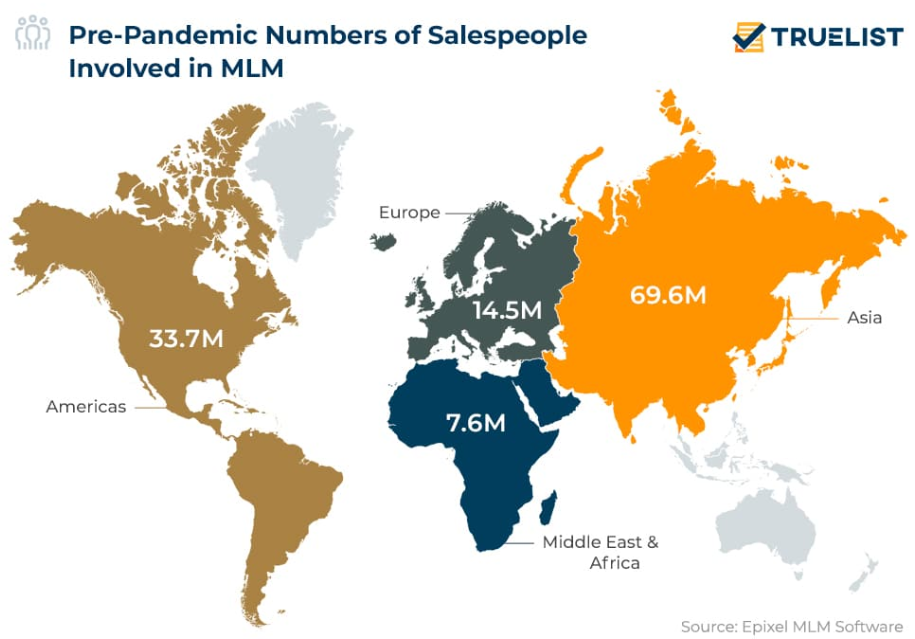 (Source: truelist.co)
(Source: truelist.co)
- The US, China, and Japan had negative growth rates of -5%, -8%, and -2.3%, respectively.
- Argentina had the highest growth rate, increasing by 58.1% in 2022.
- According to Network Marketing Industry Statistics, the Asia/Pacific region accounted for 41% of global sales, followed by the Americas at 38%, Europe at 20%, and Africa/Middle East at 1%.
- The Americas saw a decline of 3.2%, with total retail sales of $65.2 billion.
- Retail sales in Europe decreased by 1.1%, reaching $34.7 billion in 2022.
- The Africa/Middle East region reported sales of $1.4 billion and experienced a 13.3% drop in growth.
- Network Marketing Industry Statistics reported that retail sales in the Asia/Pacific region grew by 0.2%, totaling $71.5 billion.
Network Marketing Failure And Success Rate Statistics
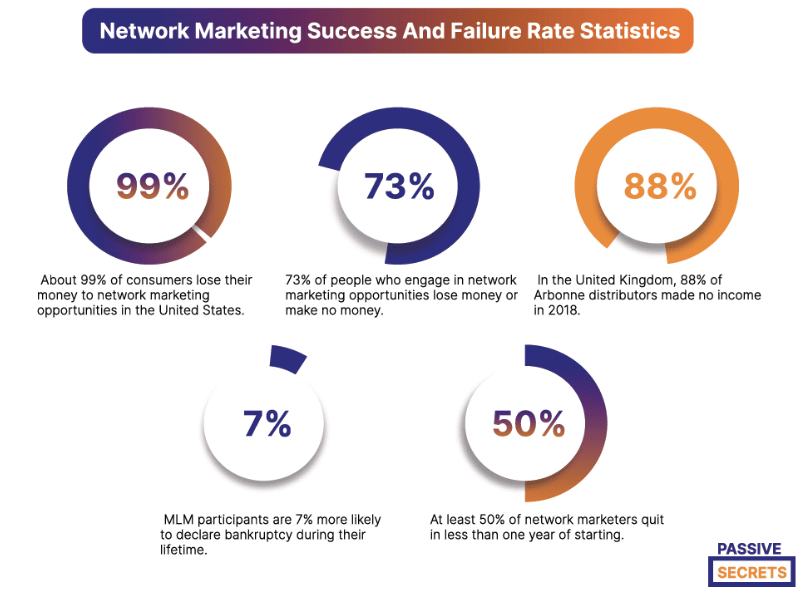 (Source: passivesecrets.com)
(Source: passivesecrets.com)
- 98% of Multi-Level Marketing Participants Lose Money: About 98% of people involved in network marketing in the US lose their money. This often happens because most of the money goes to the top marketers.
- Some Ponzi Schemes are Hidden as MLM: The growth in Ponzi schemes has caused losses of around $6.3 billion.
- High Quit Rates: Nearly half of network investors quit within their first year. By five years, 90% have given up, and after ten years, 95% are out, with only those near the top staying.
- The Majority Lose Money: About 74% of the public involved in network marketing either loses money or doesn’t make any.
- Bankruptcy Rates Among MLM Participants: According to AARP, people involved in network marketing are 8% more prone to disclose bankruptcy in their lifetime. About 18% of MLM participants declare bankruptcy, compared to 11% of those not involved in it.
Difference Between Multi-level Marketing And Pyramid Schemes
| Sr. No | MLM | Pyramid Schemes |
|
1 |
MLM organizations focus on long-term sustainability | Pyramid schemes focus on the short-term profits at the rate of participants. |
| 2 | MLM participants can think of team support and cooperation |
Pyramid scheme takes part often in operating alone |
|
3 |
MLM companies often sell many different types of products. | Pyramid schemes usually focus on just one product. |
| 4 | MLM companies give warranties or guarantees on their products. |
Pyramid schemes do not have any product guarantees. |
|
5 |
In MLM, participants can make money from their team’s sales performance. | In pyramid schemes, people only earn money by recruiting others. |
| 6 | MLM participants can make money from repeat sales to customers. |
Pyramid scheme participants earn money by recruiting new members. |
|
7 |
MLM companies are well-known in the market. | Pyramid schemes often work in secret. |
| 8 | MLM participants can get bonuses for being leaders. |
Pyramid scheme participants receive bonuses for bringing in recruits. |
|
9 |
MLM participants can make money through online sales platforms. | Pyramid scheme participants mostly rely on their connections. |
| 10 | MLM companies offer rewards for selling products. |
Pyramid schemes give rewards for bringing in new members. |
|
11 |
MLM participants can earn from the price difference in retail sales. | Pyramid scheme participants earn from the investments made by others. |
| 12 | MLM participants can earn money by demonstrating products. |
MLM participants can earn money by demonstrating products. |
|
13 |
Pyramid scheme participants mainly focus on getting others to join. | Pyramid scheme participants mainly focus on getting others to join. |
| 14 | MLM companies often provide prepared marketing materials. |
MLM companies often provide prepared marketing materials. |
|
15 |
Pyramid schemes usually don’t have professional marketing materials. | Pyramid schemes usually don’t have professional marketing materials. |
| 16 | MLM participants can set their own sales goals. |
MLM participants can set their own sales goals. |
|
17 |
Pyramid scheme participants primarily concentrate on recruitment goals. | Pyramid scheme participants primarily concentrate on recruitment goals. |
| 18 | MLM participants can earn money over time. |
Pyramid scheme participants depend on always recruiting new members. |
|
19 |
MLM companies provide details about potential earnings. | Pyramid schemes often show how much money you can make. |
| 20 | MLM participants can make a consumer state for repeated purchases. |
In pyramid schemes, people participating only focus on getting recruits. |
|
21 |
MLM companies depend on the quality and trustworthiness of their products. | Pyramid policies depend on the promise of big profits. |
| 22 | MLM companies pay attention to what customers want and follow market trends. |
Pyramid policies mostly focus on how many people they can recruit. |
|
23 |
MLM organizations offer a clear plan for how participants earn money. | Pyramid policies need a clear way to compensate participants. |
| 24 | MLM contestants can sell products directly to customers. |
Pyramid policy participants mainly try to recruit friends and family. |
|
25 |
MLM companies can operate successfully for a long time. | Pyramid policies are often short-lived and need to be more sustainable. |
| 26 | MLM companies follow laws and rules. |
Pyramid policies often operate outside legal boundaries. |
|
27 |
MLM participants have control over their business decisions. | Pyramid policy participants have very little control or influence. |
| 28 | MLM companies may have customer support services. |
Pyramid policies usually don’t provide any customer support. |
|
29 |
MLM people can earn bonuses based on their sales. |
Pyramid policy participants earn bonuses based on how many people they recruit. |
Multi Level Marketing Social Sales Statistics
- About 47% of US residents will be willing to connect with direct sellers about organization chances on social media.
- 73% of selling representatives who use social selling in their selling process perform better than those who do not. They also exceed their sales goals 22% more prone.
- 93% of top-selling person currently use social media as part of their sales strategy.
- 90% of top sales agents say that social networking sites like LinkedIn are very important for closing deals.
- Additionally, 70% of selling marketers use LinkedIn for business, compared to 66% on Facebook and 45% on Twitter.
- A strong social selling program can improve win rates by 16%, double the sales pipeline, and deliver 48% better deals.
- 94% of selling personnel need formal training in social selling.
Conclusion
Network marketing often gets criticism and has a negative image among some people, but millions still trust MLM businesses, and their user base keeps growing. Before getting involved in network marketing, it’s important to think about a few key factors. Combining network marketing with email marketing creates a strong strategy in today’s digital world.
By using the personal connections built-in network marketing, email marketing can effectively and reliably reach potential customers. Email campaigns can provide useful product details and special offers to an interested audience. At the same time, email marketing helps network marketers communicate more easily with their expanding networks.
Together, they enhance brand visibility and build genuine relationships. This combination allows entrepreneurs to create successful businesses while developing a loyal customer base, making it an effective approach for success in modern marketing. We have shed enough light on the Network Marketing Industry Statistics through this article.
Sources
FAQ.
Network marketers have a success rate of about 50%, and most begin to earn a profit within their first three months. More than 60% of network marketers have a college degree.
As of 2023, the United States was the largest direct-selling market globally, with a 22% share. Germany came next at 12%, followed by Korea at 10% and China at 9%.
Only 25% of MLM participants make a profit. The FTC reports that 99% of MLM participants lose money, but a recent AARP study shows a different picture. The AARP found that 25% of those surveyed earned a profit, 27% broke even, and about half lost money.
The industry is growing, and new technologies are giving businesses more ways to connect with their customers. Additionally, the rising popularity of network marketing is drawing in more investors and larger companies to the field.

After graduating in Electrical Engineering, Maitrayee moved into writing after working in various technical roles. She specializes in technology and Artificial Intelligence and has worked as an Academic Research Analyst and Freelance Writer, focusing on education and healthcare in Australia. Writing and painting have been her passions since childhood, which led her to become a full-time writer. Maitrayee also runs a cooking YouTube channel.







